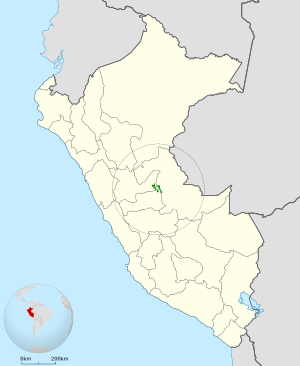Sira curassow facts for kids
Quick facts for kids Sira curassow |
|
|---|---|
| Conservation status | |
| Scientific classification | |
| Genus: |
Pauxi
|
| Species: |
koepckeae
|
 |
|
| Synonyms | |
|
Pauxi unicornis koepckeae |
|
The Sira curassow (Pauxi koepckeae) is a type of large bird that lives in the Cerros del Sira mountains in central Peru. It belongs to the family Cracidae, which includes other curassows, guans, and chachalacas.
This bird makes its home in tropical, moist mountain cloud forests. These forests are often covered in clouds, making them very wet.
Scientists first found the Sira curassow in 1969. They found a male and a female bird. Sadly, the female bird was accidentally eaten before it could be studied properly. After that, scientists did not record seeing the bird again for many years.
In 2000 and 2003, local Asháninka people helped scientists. When shown pictures of the birds, some people remembered seeing or hunting them. The Asháninka people have their own names for this bird, like quiyuri, piyori, or piuri.
The name 'Sira curassow' was suggested in 2011. It replaced the older name 'horned curassow' for this specific bird.
Contents
About the Sira Curassow
Discovery and Naming
In 1969, two birds were found in Peru. They looked like the horned curassow. But these birds were found far from where other horned curassows lived in Bolivia.
Scientists John Weske and John Terborgh studied these Peruvian birds. In 1971, they decided it was a new subspecies of the horned curassow. They named it koepckeae to honor Maria Koepcke, a famous scientist.
How Scientists Classify Birds
Scientists often debate how to group different animals. They use terms like "species" and "subspecies." A "species" is a group of animals that can breed together. A "subspecies" is a group within a species that has slight differences, often because they live in different areas.
When the Sira curassow was found, some scientists thought it should be a subspecies of the horned curassow. Others thought it should be its own separate species. Most scientists now agree that the Sira curassow and the horned curassow are different species.
| "Through an unfortunate misunderstanding, the female was plucked and prepared for the stewpot by our Peruvian assistants, who did not realize that we wished to preserve both birds as skins." |
| — This quote describes what happened to the first female Sira curassow ever found by scientists. |
Scientists also look at how different groups of birds are related. For example, they study if Pauxi (the genus for curassows) should be grouped with other similar birds like Mitu or Crax. Most scientists now agree that these are separate groups.
New studies using DNA (genetic material) can help. A study in 2004 looked at the DNA of some curassows. It suggested that the Pauxi group might not be as simple as once thought. This means some birds in the Pauxi group might be more closely related to birds in the Mitu group than to other Pauxi birds.
In 2011, another study suggested that the Sira curassow should be its own full species. This was based on how it sounds, acts, lives, and looks. The Sira curassow is only found in a very small area. As of 2009, only three specimens (dead birds collected for study) were known.
What the Sira Curassow Looks Like
The Sira curassow looks a lot like the horned curassow. However, there are some small differences.
One main difference is its "casque." This is a bony growth on top of its head. The Sira curassow's casque is more rounded, like an oval, and not as tall as the horned curassow's.
Also, the white tips on its outer tail feathers are narrower. The four feathers in the very middle of its tail do not have any white color at all. But scientists say this last feature can change a lot between individual birds.
Protecting the Sira Curassow
The Sira curassow is in great danger. It is listed as critically endangered by BirdLife International for the IUCN. This means it is at very high risk of disappearing forever.
The biggest threats to this bird are:
- Habitat destruction: Its forest home is being cut down or changed.
- Hunting: Local people sometimes hunt the birds for food.
Scientists believe there are fewer than 250 Sira curassows left in the wild. In 2011, one study estimated there might be around 400 birds. But later estimates suggest the number is much lower.
The area where these birds live is about 550 km2 (212 sq mi). This small area is mostly within the El Sira Communal Reserve, which is a protected area. Even though it's protected, the birds are still at risk.
Because the estimated number of birds has gone down, scientists believe the population is shrinking. The main threat is occasional hunting by the local Asháninka people for food.
See also
 In Spanish: Paují unicornio peruano para niños
In Spanish: Paují unicornio peruano para niños


